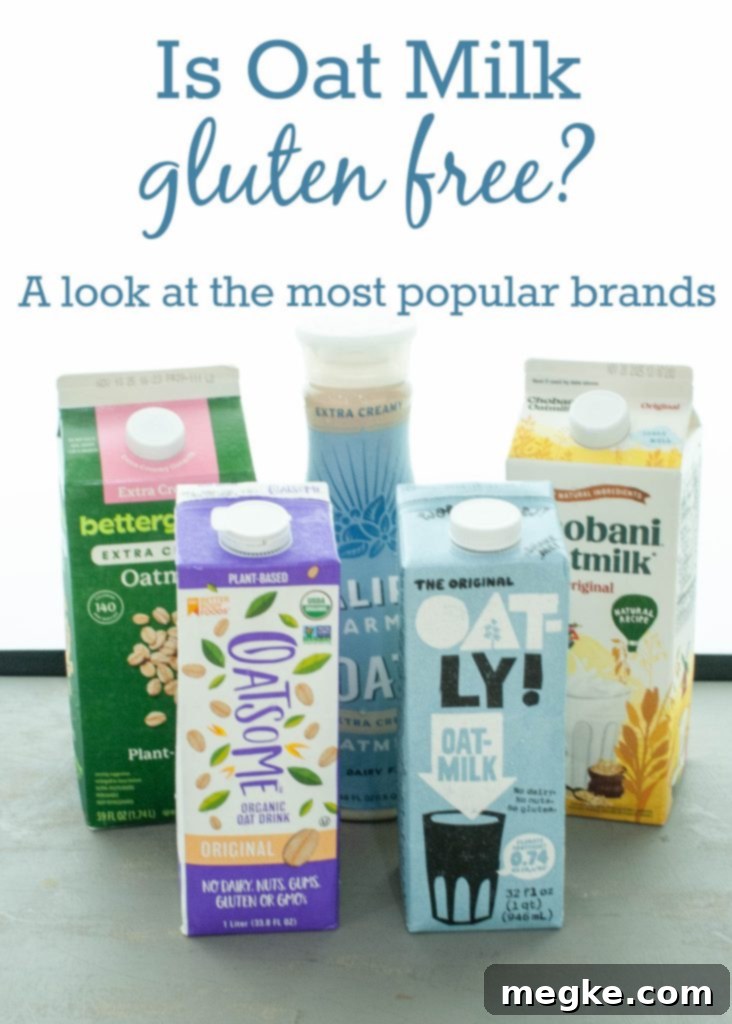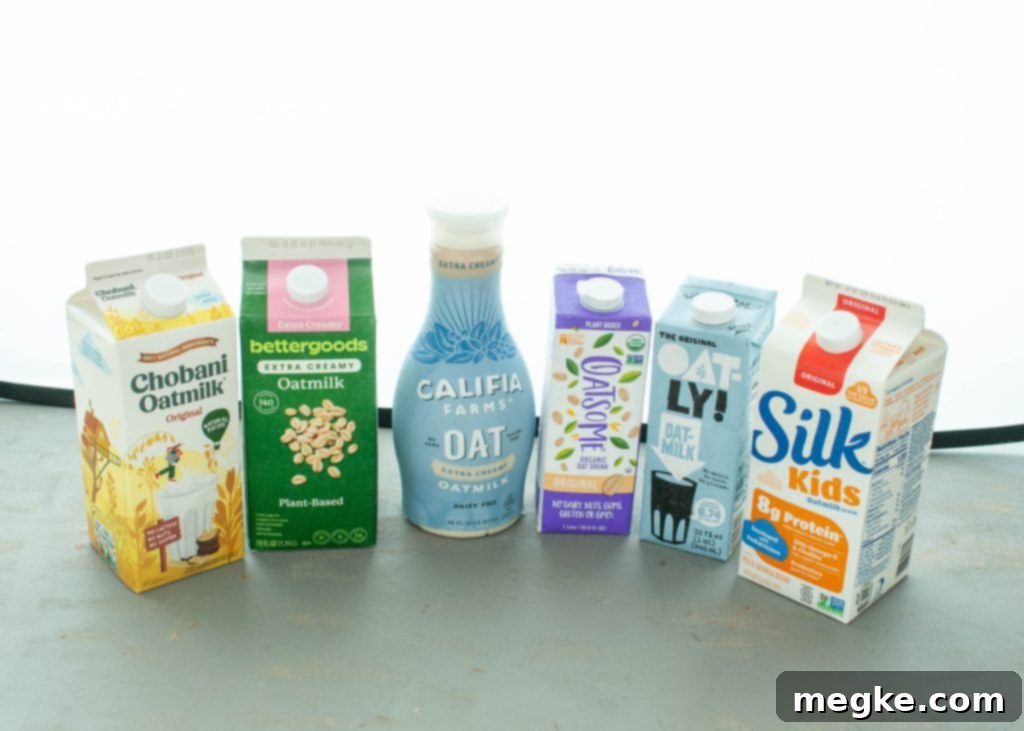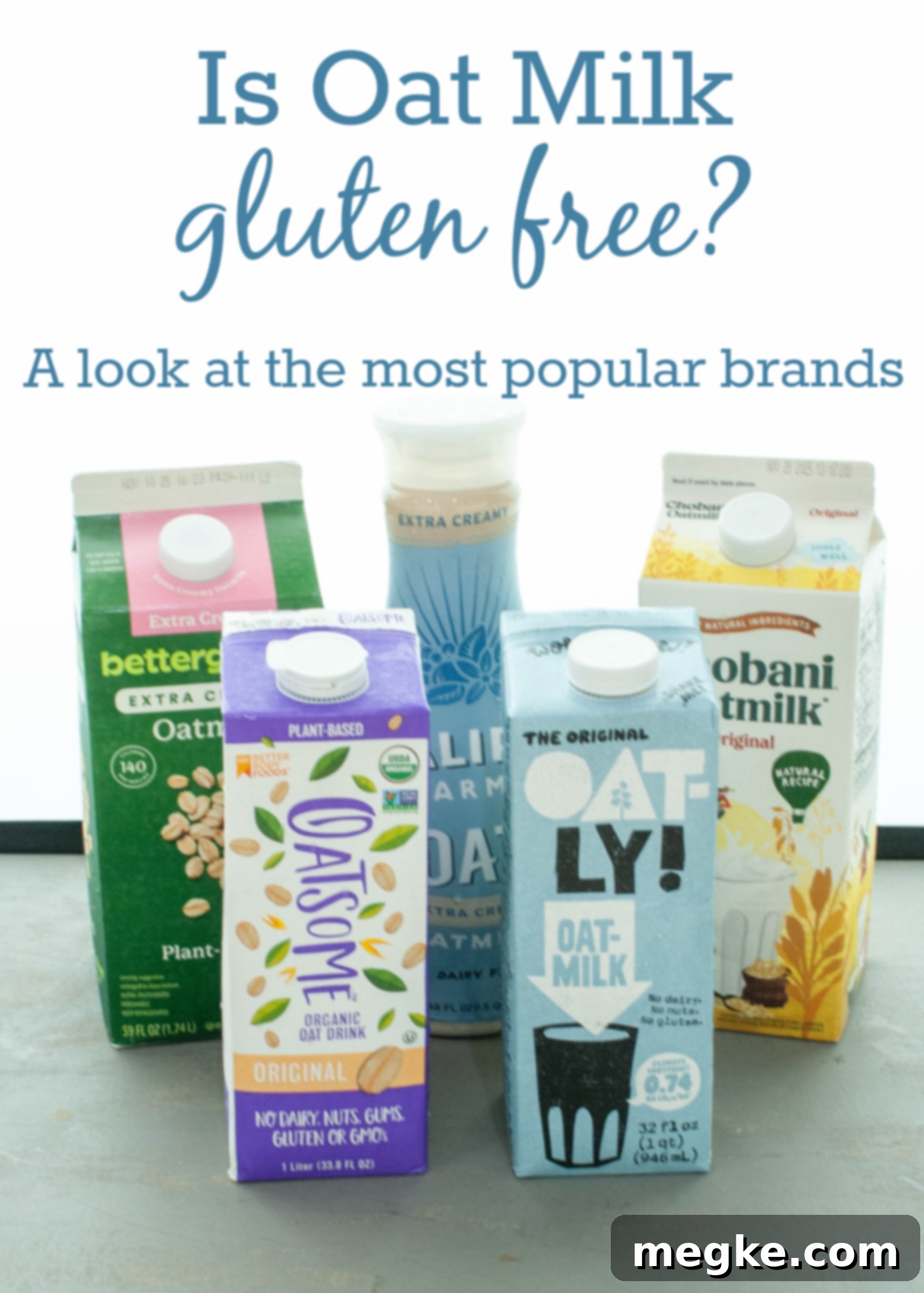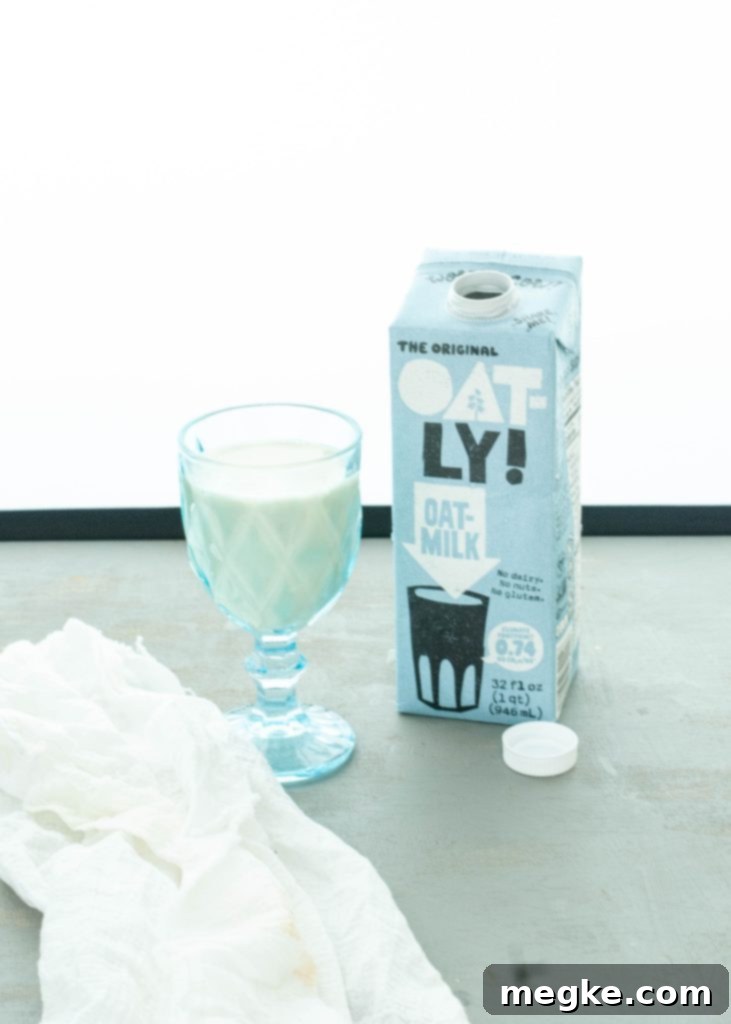Navigating Gluten-Free Oat Milk: Your Essential Guide to Brands, Safety, and Dairy-Free Living
As the awareness of dietary sensitivities grows, more and more individuals are seeking alternatives to common food staples. For many, this includes avoiding gluten and dairy, two ingredients widely present in our diets. While navigating a gluten-free and dairy-free lifestyle can be challenging, especially when it comes to everyday essentials like milk, popular plant-based options like oat milk have emerged. But if you adhere to a strict gluten-free diet, is oat milk truly a safe choice? This comprehensive guide will explore the nuances of gluten in oats, detail what to look for on labels, and provide an in-depth breakdown of popular oat milk brands and their specific gluten-free claims, empowering you to make informed decisions for your health and diet.

Understanding the Gluten-Free Debate Around Oats
The topic of oats within the gluten-free community is frequently met with varying opinions and a degree of controversy. If you were to survey a group of individuals with Celiac disease or gluten intolerance about their comfort level with oats, you would likely receive a divided response. This sentiment was echoed in an informal poll conducted on Instagram Stories, where out of 40 gluten-free readers, 10 expressed discomfort with consuming oat milk. This division stems from a combination of scientific understanding and practical considerations.
Fundamentally, oats themselves are not inherently a gluten-containing grain. Gluten, a protein composite found in wheat, barley, and rye, is naturally absent from pure oats. The primary concern for those on a strict gluten-free diet arises from the way oats are cultivated, harvested, and processed. Cross-contamination, often referred to as cross-contact, is a significant risk. Oats are frequently grown in fields adjacent to wheat or barley, sharing equipment during harvest and transportation. Furthermore, many processing facilities handle multiple grains, including gluten-containing ones, on the same production lines, leading to potential mixing and contamination.
This risk of cross-contamination means that conventionally processed oats may contain traces of gluten, making them unsafe for individuals with Celiac disease or severe gluten sensitivity. For this reason, many who diligently follow a gluten-free diet will exclusively seek out and consume products made with certified gluten-free oats. These oats are typically grown under specific “purity protocol” conditions, which involve dedicated fields, specialized harvesting equipment, and processing in facilities entirely free from gluten-containing grains, or in facilities with stringent measures to prevent cross-contact. This commitment to separate processing and rigorous safety controls ensures that the final oat product meets strict gluten-free standards and offers peace of mind.
Purity Protocol vs. Mechanically Sorted Oats
It’s important to distinguish between different methods of producing “gluten-free” oats. The gold standard is the “Purity Protocol” method, where oats are specifically grown, harvested, and processed to prevent any gluten contact from field to package. This method is often preferred by those with Celiac disease due to its comprehensive approach to avoiding contamination. Another method involves “mechanically sorted” oats, where regular oats are sorted to remove gluten-containing grains. While this can reduce gluten levels, it may not guarantee the same level of purity as the Purity Protocol and might still carry a higher risk of trace gluten.
Understanding Avenin Sensitivity
Beyond cross-contamination, a smaller percentage of individuals with Celiac disease may also experience a reaction to avenin, a protein naturally found in oats. Avenin is similar in structure to gluten, and for some, it can trigger an autoimmune response. While the majority of celiacs can safely consume pure, uncontaminated oats, it’s a factor worth considering, and listening to your body’s response is always crucial when introducing new foods.

Detailed Brand Analysis: Which Oat Milks Are Gluten-Free?
Choosing the right oat milk can be daunting with so many options available. To simplify your decision-making process, we’ve meticulously researched and compiled information on popular oat milk brands, detailing their gluten-free claims and ingredient lists. This allows you to make an informed choice without the hassle of sifting through multiple websites. *Always remember that product formulations can change, so it’s essential to verify the most current information on the product packaging you have in hand before consumption.*
Chobani Oatmilk Original
**Gluten-Free Claim:** The front of the Chobani Oatmilk Original package prominently displays “No lactose, no nuts, no gluten.” This direct statement from the manufacturer indicates their commitment to producing a gluten-free product.
**Ingredients:** “Oat blend (water, whole grain oats), contains 2% or less of: rapeseed oil, sea salt, vitamin D1 (yeast extract), calcium carbonate, gellan gum.”
**Our Analysis:** Chobani clearly labels its oat milk as “gluten-free,” which is a strong indicator for many consumers. However, it’s important to note that the packaging doesn’t mention third-party certification (like GFCO) or explicitly state that the “oat blend” is made from certified gluten-free oats. For individuals with Celiac disease or extreme gluten sensitivity, a third-party certification offers an additional layer of assurance regarding cross-contamination prevention. Those who are comfortable with a manufacturer’s direct claim and are not highly sensitive might find this a suitable option. The inclusion of rapeseed oil and gellan gum are standard for texture and stability in many plant-based milks.
Bettergoods Extra Creamy Oatmilk
**Gluten-Free Claim:** There are no specific marketing call-outs on this Bettergoods package explicitly stating “gluten-free.” This absence of a direct claim can be a red flag for those on a strict gluten-free diet.
**Ingredients:** “Oatmilk (water, oats), vegetable oil (high oleic canola and/or sunflower oil), calcium carbonate, dipotassium phosphate, salt, gellan gum, Vitamin B12, Zinc, Vitamin B2 (riboflavin), Vitamin A Palmitate, Vitamin D2.”
**Our Analysis:** The lack of any “gluten-free” labeling on the packaging means that this product does not make an explicit claim to meet gluten-free standards. Without this, and without specific mention of “gluten-free oats” in the ingredient list, it’s safest to assume that the oats used may be subject to conventional processing and potential cross-contamination. For those with Celiac disease or significant gluten sensitivities, this brand would likely be avoided in favor of options with clear gluten-free declarations. Furthermore, the absence of a direct customer service contact number on the package makes it difficult to inquire directly about their gluten handling protocols. Consumers prioritize transparency and verified claims will likely look for other brands.
Oatly Oat Milk (Original)
**Gluten-Free Claim:** Oatly stands out with prominent “No dairy, no nuts, no gluten” claims on the front of its packaging. Crucially, the side of the package further features a “Certified Gluten Free by the CFCO.org” seal, alongside a “Glyphosate Residue Free” claim. This dual certification offers a high level of assurance.
**Ingredients:** “Oat base (water, oats). Contains 2% or less of: low erucic acid rapeseed oil, dipotassium phosphate, calcium carbonate, tricalcium phosphate, sea salt, dicalcium phosphate, riboflavin, vitamin A acetate, vitamin D2, vitamin B12.”
**Our Analysis:** Oatly is a strong contender for individuals seeking confidently gluten-free oat milk. The presence of third-party certification from CFCO.org (likely the Gluten-Free Certification Organization, a respected certifying body) signifies that their product has undergone rigorous testing and adherence to strict gluten-free standards, typically below 10-20 ppm of gluten. This level of verification is highly valued by individuals with Celiac disease. The explicit “oat base (water, oats)” ingredient, combined with certification, strongly implies the use of Purity Protocol or similarly processed gluten-free oats. Its commitment to transparency and certification makes it a preferred choice for many navigating a strict gluten-free diet.
Silk Kids Oatmilk Blend
**Gluten-Free Claim:** The side of the Silk Kids Oatmilk Blend package clearly identifies the product as gluten-free, providing a direct manufacturer claim.
**Ingredients:** “Pea and Oatmilk Blend (water, pea protein, oat concentrate), Sunflower Oil, Cane Sugar, Contains 1% or less of the following: DHA Algal Oil, Inulin, Vitamin and Mineral Blend (Dipotassium Phosphate, Calcium Phosphate, Magnesium Sulfate, Calcium Carbonate, Choline Chloride, Potassium, Iodide, Vitamin A Palmitate, Vitamin D2, Vitamin B12, Riboflavin [B2]), Sea Salt, Natural Flavor, Gellan Gum, Sodium, Ascorbate, and Vitamin E (To preserve Freshness).”
**Our Analysis:** Silk Kids Oatmilk Blend makes a straightforward “gluten-free” claim on its packaging. While this is reassuring, it’s important to note that, similar to some other brands, it does not explicitly mention third-party gluten-free certification. The ingredient list also specifies “oat concentrate” rather than “gluten-free oats.” The addition of pea protein and DHA algal oil indicates a focus on enhanced nutrition, particularly for children. For those comfortable with a manufacturer’s direct claim, this could be an acceptable option, but individuals with Celiac disease or high sensitivity might prefer options with external verification. The blend also includes cane sugar, which might be a factor for those monitoring sugar intake.
Califia Farms Extra Creamy Oatmilk
**Gluten-Free Claim:** Califia Farms Extra Creamy Oatmilk proudly self-identifies as “gluten-free” on both the front and back of its packaging, providing clear labeling for consumers.
**Ingredients:** “Oatmilk (water, oats), Sunflower Oil, Dipotassium Phosphate, Calcium Carbonate, Tricalcium Phosphate, Sea Salt, Vitamin A Palmitate, Vitamin D2.”
**Our Analysis:** Califia Farms provides a clear “gluten-free” statement, which is a strong positive for consumers seeking this attribute. However, as with several brands, there’s no explicit mention of third-party certification for their gluten-free status, nor does the ingredient list specify “gluten-free oats.” The formulation, with sunflower oil, aims for an “extra creamy” texture, appealing to those who miss the richness of dairy milk. For individuals with less severe sensitivities or those who trust manufacturer claims, this could be a viable choice. Those requiring the highest level of assurance, typical for Celiac disease, might continue to prioritize certified options. The use of sunflower oil is often preferred by some consumers over rapeseed/canola oil.
Oatsome Organic Oat Drink
**Gluten-Free Claim:** Oatsome Organic Oat Drink makes comprehensive claims on its packaging, stating “No dairy, nuts, gums, gluten or GMO’s.” This positions it as a highly allergy-friendly and clean-label option.
**Ingredients:** “Oat Milk (Water, Whole Grain Gluten-Free Organic Oats), Organic Sunflower Oil, Sea Salt, Calcium Carbonate, Riboflavin, Vitamin D, Vitamin B12.”
**Our Analysis:** Oatsome offers significant reassurance with its “gluten-free” claim, enhanced by the explicit mention of “Whole Grain Gluten-Free Organic Oats” in its ingredient list. This specific wording suggests that they are using oats processed to minimize gluten contamination. The “Organic” certification also indicates adherence to certain agricultural standards. While a third-party gluten-free certification seal isn’t explicitly mentioned, the combination of the direct claim and the ingredient specification makes this a strong choice for many gluten-free consumers. The absence of gums and GMOs further appeals to those looking for minimal additives and natural ingredients.
Kirkland Signature Organic Non-Dairy Oat Beverage
**Gluten-Free Claim:** As of the time of this research, direct packaging information was not available (requiring a Costco membership to verify in-store). Based on a direct inquiry to Costco customer service, they reported: “Organic oats are naturally free of gluten. The Kirkland Signature Organic Oat beverage is gluten free but is not 3rd party certified gluten free. The manufacturing site producing the organic oat beverage does not have gluten in the facility. There is no potential for cross contact at the beverage manufacturing site.”
**Ingredients:** (Not listed on the product’s public web page)
**Our Analysis:** The information obtained directly from Costco customer service is quite specific and reassuring. The claim that “the manufacturing site producing the organic oat beverage does not have gluten in the facility” is a strong indicator of low cross-contamination risk, akin to what one would expect from a Purity Protocol. However, the lack of this information on the product label or public website, coupled with no third-party certification, means consumers must rely on direct inquiry. This extra step can be inconvenient and might deter those who prefer immediate visual confirmation. If these internal protocols are truly adhered to, this could be a very safe option, but the lack of public transparency on the packaging makes it a less straightforward choice for immediate trust.
Malk Organic Oat Milk
**Gluten-Free Claim:** Malk’s website indicates that their product uses “Organic Gluten Free Oats.” While there isn’t a prominent “gluten-free” label on the front of their packaging like some other brands, the specific ingredient declaration is key.
**Ingredients:** Filtered Water, Organic Gluten Free Oats, Himalayan Pink Salt.
**Our Analysis:** Malk takes a minimalist approach with its ingredients, focusing on purity. The explicit listing of “Organic Gluten Free Oats” in the ingredient list is a very strong indicator of its gluten-free status, suggesting the use of oats sourced and processed to minimize gluten. While a third-party certification seal isn’t prominently displayed (or mentioned in the available information), the direct declaration of “Gluten Free Oats” provides substantial confidence. This brand caters to consumers seeking products with minimal, high-quality ingredients, and the clear identification of gluten-free oats in the ingredients list makes it a solid choice for those prioritizing this. The simplicity of the formulation also means no added oils or gums, which appeals to a specific segment of the health-conscious market.
Beyond Gluten: Other Crucial Factors to Consider When Choosing Oat Milk
While ensuring your oat milk is gluten-free is a primary concern for many, a multitude of other factors can influence your choice. The ideal oat milk often comes down to individual dietary needs, preferences, and ethical considerations. Here’s a deeper dive into additional aspects to weigh when selecting your preferred plant-based milk:
Nutritional Profile and Fortification
For many transitioning from dairy milk, the nutritional content of plant-based alternatives is critical. Cow’s milk is rich in calcium, vitamin D, and vitamin B12. Many oat milks are fortified with these nutrients to match or even exceed the levels found in dairy. Check the nutrition label to see if the oat milk provides comparable amounts of these essential vitamins and minerals, especially if it’s a primary milk source in your diet. Some brands may also add protein (like pea protein in Silk Kids) or healthy fats like DHA for enhanced nutritional value. If you’re specifically using oat milk as a nutritional substitute, consulting a registered dietitian or nutritionist can provide personalized guidance.
Ingredient Quality and Additives
Beyond oats, the other ingredients can vary significantly between brands.
- Oils: Brands use different oils for creaminess and texture, such as rapeseed oil (canola), sunflower oil, or high oleic canola oil. Some consumers have preferences or concerns regarding specific types of oils, with a growing trend towards minimizing highly processed oils.
- Sweeteners: While some oat milks are unsweetened, many contain added sugars like cane sugar. Pay attention to the sugar content, especially if you’re managing blood sugar levels or trying to reduce overall sugar intake.
- Gums and Stabilizers: Ingredients like gellan gum are common in plant-based milks to prevent separation and improve mouthfeel. While generally recognized as safe, some individuals prefer products without gums due to digestive sensitivities or a preference for “cleaner” labels.
- Organic and Non-GMO Status: For those concerned about pesticides and genetically modified organisms, looking for organic and non-GMO certifications can be important.
Taste, Texture, and Culinary Applications
The sensory experience of oat milk is highly subjective. Some prefer a thinner consistency, while others seek an “extra creamy” option that mimics whole milk. The flavor profile can also vary, from a neutral taste to a subtle sweetness from the oats themselves. Your choice might depend on how you plan to use it: in coffee (barista blends are designed not to curdle), in cereal, for baking, or simply as a refreshing drink. Experimentation with different brands might be necessary to find your perfect match.
Environmental Impact
The environmental footprint of food choices is increasingly a concern. Plant-based milks generally have a lower environmental impact than dairy. Among plant milks, oat milk is often lauded for its relatively low water and land usage compared to almond milk. For eco-conscious consumers, exploring brands with transparent sustainability practices can be an additional factor.
Availability and Cost-Effectiveness
Practical considerations like availability and price point play a significant role. Some niche or premium brands might be harder to find or come at a higher cost. For regular consumption, finding a widely available and budget-friendly option that meets your dietary requirements is often key. As observed with Malk, not all brands are universally stocked, requiring some diligence in sourcing.
Allergy Considerations (Beyond Gluten)
One major advantage of oat milk for many is its typically nut-free and soy-free nature, making it a safe alternative for individuals with common allergies to nuts or soy, which are often found in other dairy-free milks (e.g., almond milk, soy milk). This makes oat milk a versatile option for multi-allergy households.
Ultimately, the decision of which oat milk is best for you is a personal one, influenced by a unique combination of health needs, ethical values, and lifestyle factors. This guide aims to equip you with the knowledge to navigate the options effectively and confidently. We wish you the best in making the choice for your own individual diet, and hope this information, all in one spot, helped set you on a path towards making a good choice for you.
Looking for more gluten-free guidance? Explore our other helpful posts: discover which taco seasonings are gluten-free, learn which tortilla chips are gluten-free, find out which candy is gluten-free, and identify which cereals are gluten-free to help you with other delicious and safe food choices!

